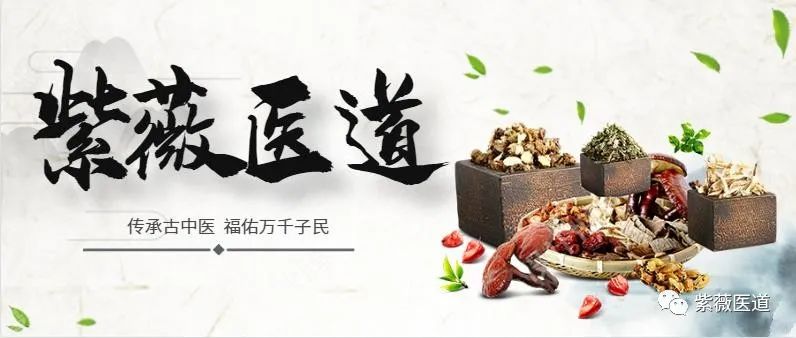
The “Six Excessive Evils” (Liù Yín) refer to the six types of external pathogenic factors: Wind (Fēng), Cold (Hán), Heat (Shǔ), Dampness (Shī), Dryness (Zào), and Fire (Huǒ). The term “excessive” implies an overabundance or infiltration. The onset of diseases caused by the Six Excessive Evils primarily occurs under two conditions. First, when the climate in a region deviates significantly from the usual patterns, either excessively or insufficiently, or when there are unusual climatic changes, these six energies can transform into the Six Excessive Evils, invading the body and causing illness. Second, when the body’s righteous Qi (Zhèng Qì) is weak and its ability to adapt is low, climatic changes can act as pathogenic conditions leading to disease. The onset of the Six Excessive Evils is characterized by external invasion, seasonality, regionality, and a combination of these factors. In addition to climatic factors, the pathogenic effects of the Six Excessive Evils also include biological (bacteria, viruses, etc.), physical, and chemical factors that cause pathological reactions in the body.
1. Pulse Manifestation of Wind Evil
When the Wind energy is excessive and harms the body, it is termed Wind Evil. Wind is a Yang evil characterized by its light, upward, and erratic nature; it has the properties of ascending, externalizing, and being unstable. Wind Evil is known for its mobility and unpredictability, often accompanying other evils to cause disease.
(1) Elements of Pulse Manifestation for Wind Evil
1. Local Pulse Elements
Protruding: Wind Evil easily attacks Yang positions, often entering from above, thus the pulse at the cun position may show small, grain-like or soft protrusions.
2. Overall Pulse Elements
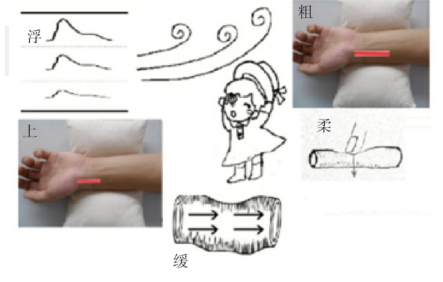
Upward, Floating: Wind Evil stimulates the movement of Qi and blood towards the upper and outer regions, hence the pulse is upward and floating.
Rough, Soft: The nature of Wind is to disperse and open the skin, resulting in a rough pulse and decreased tension in the radial artery walls.
Slow: Wind Evil disperses and opens the skin, leading to a rough pulse and decreased tension in the radial artery walls.
(2) Systematic Differentiation of Pulse Manifestation
In clinical pulse diagnosis, the characteristic of “floating, soft, and slow” can indicate the diagnosis of Wind Evil. Based on the accompanying pulse manifestations, different syndromes can be differentiated. If the cun position also shows a “protruding” pulse element, it indicates Wind Evil disturbing the upper; if the overall pulse shows “rough,” “soft,” “slow” elements, it indicates Wind Evil attacking the exterior.
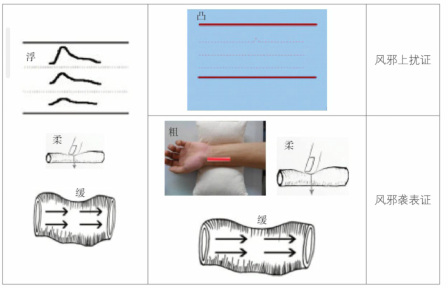
2. Pulse Manifestation of Cold Evil
Excessive cold that harms the body is termed Cold Evil. Cold is a Yin evil characterized by congealing, obstructing, and retracting properties, which can easily cause Qi to contract, and blood and fluids to congeal, leading to contraction and spasms of the skin, meridians, and muscles. Cold Evil is commonly seen in winter but can also occur in other seasons. When Cold invades the skin and obstructs the Yang Qi, it is termed “Cold Damage”; when Cold penetrates deeply and injures the Yang Qi of the internal organs, it is termed “Internal Cold”.
(1) Elements of Pulse Manifestation for Cold Evil
1. Local Pulse Elements
Cold: Local areas affected by cold lose warmth, resulting in a decrease in temperature at the corresponding pulse position.
Stiff, Constricted, Fine: The nature of cold causes contraction, leading to increased tension in the radial artery walls at the corresponding pulse position; the pulse becomes limited in its surrounding pulsation, appearing fine.
Linear Pulsation: A linear pulse may appear on the radial artery’s radial side corresponding to the area affected by cold.
2. Overall Pulse Elements
Stiff, Constricted, Fine, Deep, Cold: Cold Evil fills the body, leading to changes in the overall pulse.
Slow, Weak: Yang Qi is weak and unable to warm and stimulate, hence the pulse is slow and weak.
Moving, Floating: The righteous Qi is outward to resist the evil, hence the pulse is floating and unstable.
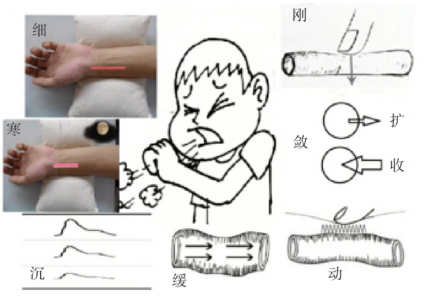
(2) Systematic Differentiation of Pulse Manifestation
In clinical pulse diagnosis, the characteristic of stiff, constricted, and cold can indicate the diagnosis of Cold Evil. Based on the differences in accompanying pulse elements, different syndrome groups can be differentiated.
If the pulse shows characteristics of “thick,” “moving,” “hot”, it indicates Cold Evil binding the exterior, transforming into heat; if it shows “cold,” “slow,” “weak,” “deep”, it indicates Cold Evil injuring Yang; if it shows “thin”, it indicates Cold Evil invading externally, with phlegm and fluids generated internally.
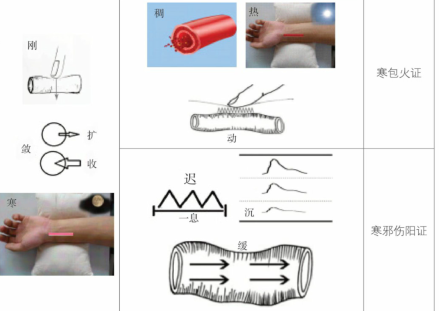
3. Pulse Manifestation of Heat Evil
After the summer solstice and before the autumn equinox, excessive heat can harm the body, termed Heat Evil. Heat Evil has a clear seasonality, being a Yang evil, transformed from the intense heat of summer, characterized by its hot nature; it tends to disturb the spirit, open the skin, cause excessive sweating, and injure Qi and fluids. The summer season is often rainy and humid, making it easy for heat to combine with dampness. Heat Evil can be classified into “Heat Injury” and “Heat Stroke” based on the onset speed and severity of the condition.
(1) Elements of Pulse Manifestation for Heat Evil
1. Local Pulse Elements:
Moving, Hot: Heat fills the body, radiating outward, resulting in a vigorous and dry pulse at the right chi position.
Dry: Heat Evil consumes the body’s Yin blood and fluids, leading to a lack of nourishment in the pulse pathway, hence the left chi pulse appears dry.
2. Overall Pulse Elements:
Hot, Rapid, High: Heat fills the body, causing pathological hyperactivity of Yang Qi, resulting in a hot, rapid, and high pulse.
Stiff or Soft: Yin heat and cold evil cause the skin and muscle tissues to contract, increasing the tension in the radial artery walls; in cases of excessive dampness, the meridians may relax, leading to decreased tension in the radial artery walls.
Thick, Slippery: Excessive heat and dampness lead to increased blood viscosity, resulting in a thick and slippery pulse.
Vascular walls and surrounding tissue boundaries appear “blurred”: The sticky nature of dampness leads to thickened blood, affecting the normal conduction of vibrations between the vascular walls and surrounding tissues.
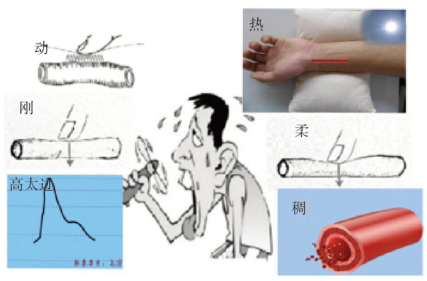
(2) Systematic Differentiation of Pulse Manifestation
In clinical pulse diagnosis, the characteristic of “stiff, dry, and slippery” can indicate the diagnosis of Yin Heat Evil; the characteristic of “floating, scattered, and hot” can indicate the diagnosis of Heat Evil. Based on the differences in accompanying pulse elements, different syndrome groups can be differentiated.
In the case of Yin Heat Evil, if the right chi pulse shows a very obvious “stiff” characteristic and has a “constricted” appearance, it indicates Yin Heat penetrating internally; if the pulse shows “thin,” “rough,” “dry” elements, it indicates Heat Evil injuring fluids and causing dryness.
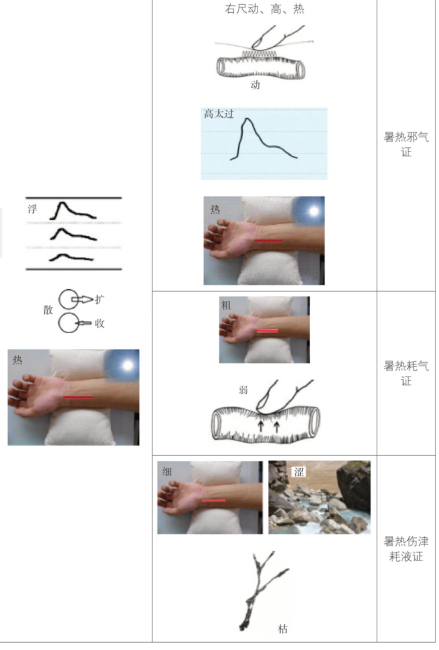
4. Pulse Manifestation of Damp Evil
Excessive dampness that harms the body is termed Damp Evil. Dampness is the primary energy of the long summer, hence Damp Evil is prevalent during this season. Diseases caused by Damp Evil are termed external damp diseases, often resulting from exposure to humid climates, rain, or working in wet environments. Dampness is a heavy and turbid evil, being a Yin evil that can damage the body’s Yang Qi, stagnating in the internal organs and meridians, obstructing the flow of Qi; it is characterized by heaviness, turbidity, and stagnation, leading to symptoms of heaviness and a sense of obstruction.
(1) Elements of Pulse Manifestation for Damp Evil
1. Local Pulse Elements:
Thick, Slippery, Weak: The heavy and turbid nature of dampness obstructs the middle burner, leading to unfavorable Qi flow, resulting in a thick, slippery, and weak pulse at the right guan position.
Stiff: Damp Evil infiltrates the skin or limbs, causing obstruction in the meridians, leading to increased tension in the radial artery at the corresponding pulse position.
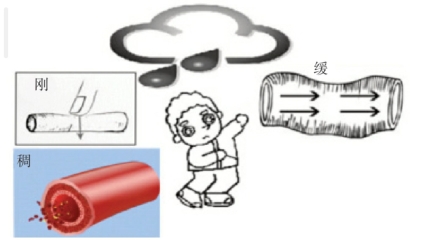
2. Overall Pulse Elements:
Deep, Short, Weak: Damp Evil obstructs Yang Qi, leading to a deep pulse; when Qi flow is obstructed, the pulse’s amplitude decreases, and the rate of change slows.
Downward: The nature of dampness tends to descend, often affecting the lower parts of the body.
Soft: The soft nature of dampness leads to decreased tension in the radial artery walls.
Rough, with blurred boundaries between the vascular wall and surrounding tissues: Dampness causes an increase in body fluid volume, filling the pulse pathway; the retention of dampness leads to phlegm accumulation, affecting the resonance between the pulse pathway and surrounding tissues.

(2) Systematic Differentiation of Pulse Manifestation
In clinical pulse diagnosis, the characteristic of “thick, slippery, and short” can indicate the diagnosis of Damp Evil. Based on the differences in accompanying pulse elements, different syndrome groups can be differentiated.
If the pulse shows characteristics of “stiff”, it indicates the presence of Damp Evil obstructing the meridians; if it shows “short,” “weak,” and “more coming than going”, it indicates the presence of Damp Evil obstructing Qi flow; if it shows “thin,” “rough,” “soft,” and “slippery”, it indicates the presence of Damp Evil and internal stagnation of fluids; if it shows “hot,” “thick”, it indicates the presence of Damp Evil transforming into heat; if it shows “thin,” “weak,” “cold”, it indicates the presence of Damp Evil injuring Yang.
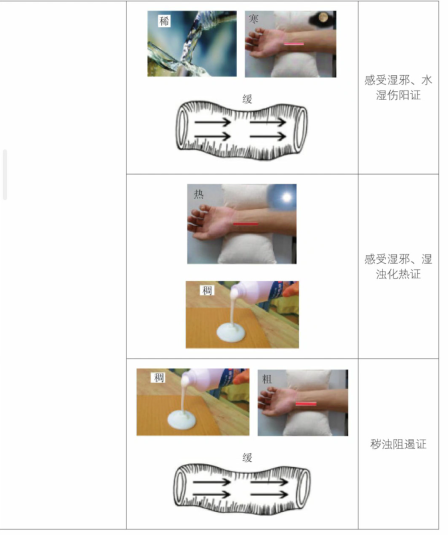
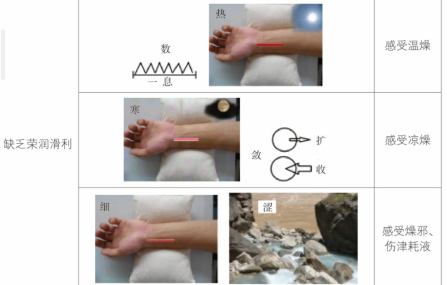
5. Pulse Manifestation of Dry Evil
Dryness is the primary energy of autumn; when excessive dryness invades the body, it is termed Dry Evil. The nature of Dry Evil is dry, and when it invades the body, it can easily harm the body’s fluids, leading to various symptoms of dryness, particularly affecting the lungs, which are the primary organs for exchanging Qi with the external environment, resulting in symptoms such as dry cough with little phlegm or blood-streaked phlegm.
(1) Elements of Pulse Manifestation for Dry Evil
1. Local Pulse Elements:
Rough, Dry: Dry Evil harms the fluids, making the right cun pulse often rough; fluid deficiency leads to insufficient nourishment of the blood vessels, often seen in the left chi pulse.
2. Overall Pulse Elements:
Fine: Dry Evil harms the fluids, leading to insufficient blood volume and filling.
Rapid, Hot: When experiencing warm dryness, the heat evil is internally abundant, leading to an increased heart rate.
Constricted, Cold: When experiencing cool dryness, the blood vessels constrict; Yang Qi is injured, leading to poor warming.
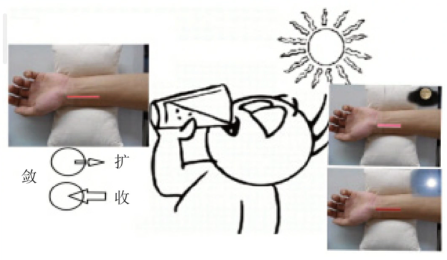
3. Evolution of Pulse Manifestation:
The right chi pulse may be rough and strong: Dry Evil harms the fluids, leading to fluid deficiency, causing constipation and difficulty in bowel movements.
(2) Systematic Differentiation of Pulse Manifestation
In clinical pulse diagnosis, the characteristic of “lacking nourishment and lubrication” can indicate the diagnosis of Dry Evil. Based on the differences in accompanying pulse elements, different syndrome groups can be differentiated.
If the pulse shows characteristics of “rapid,” “hot”, it indicates the presence of Dry Evil with heat; if it shows “cold,” “constricted”, it indicates the presence of Dry Evil with cold; if it shows “fine,” “rough,” and “dry”, it indicates the presence of Dry Evil injuring fluids and causing fluid loss.
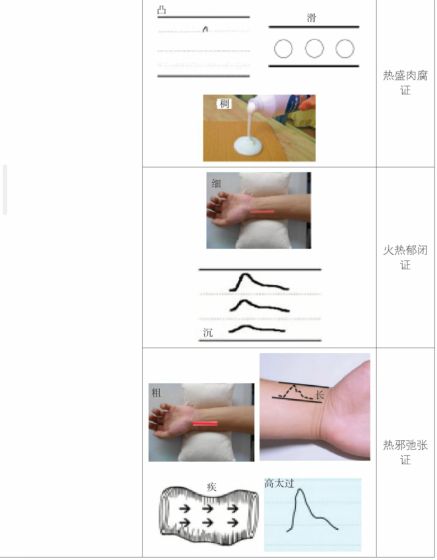
6. Pulse Manifestation of Fire Evil
Fire Evil can occur in all four seasons; whenever external heat is excessive, it invades the body, leading to Fire Evil. Fire is a Yang evil, causing diseases characterized by excess heat; it tends to rise and can consume fluids, leading to the loss of Yin fluids; excessive heat can also provoke wind; Fire Evil can invade the Ying and blood, disturbing the spirit; heat entering the Ying and blood can cause blood to move erratically; excessive heat can lead to blood stagnation and tissue necrosis.
(1) Elements of Pulse Manifestation for Fire Evil
1. Local Pulse Elements:
Hot: When heat accumulates in a specific area of the body, the corresponding pulse position will feel hot.
Rough: When heat fills the body, it forces blood to move, leading to increased blood flow in the corresponding pulse position, hence the pulse appears rough.
Slippery: When heat enters the Ying and blood, it can cook the fluids, leading to a slippery pulse.
2. Overall Pulse Elements:
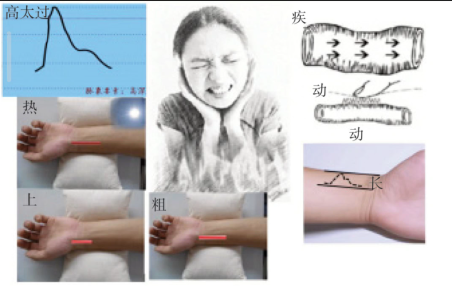
Hot (characteristic pulse manifestation of Fire Evil): Fire fills the body, reflected in the radial artery as a strong sensation of heat.
Moving, High, Rough: The righteous Qi resists the evil, leading to the pulse becoming rough, and the rising phase of the pulse shows a “restless” appearance, especially at the beginning of the pulse.
Strong, Rapid, Long: When heat fills the body, the heart rate increases, leading to faster blood flow, resulting in increased internal pressure in the radial artery and a longer pulse conduction distance.
Upward: The fiery nature rises, impacting the head and face, leading to the pulse manifesting as expanding towards the distal wrist.
Rapid, Weak, More Coming than Going: When heat is excessive, it stirs the blood flow, leading to a rapid pulse that comes quickly but leaves slowly, disrupting the normal pulsation.
(2) Systematic Differentiation of Pulse Manifestation
In clinical pulse diagnosis, the characteristic of “hot, moving, and strong” can indicate the diagnosis of Fire Evil. Based on the differences in accompanying pulse elements, different syndrome groups can be differentiated.
If the pulse shows characteristics of “rough,” “long,” “rapid,” “strong,” “high”, it indicates the presence of Fire Evil, with heat expansion; if it shows “slippery,” “rapid,” “high”, it indicates the presence of Fire Evil, with internal accumulation of heat; if it shows “slippery,” “rapid,” “fine,” “high”, it indicates the presence of Fire Evil, with heat entering the Ying and blood; if it shows “fine,” “constricted”, it indicates the presence of Fire Evil, with heat generating wind; if it shows “fine,” “dry”, it indicates the presence of Fire Evil, with heat injuring Yin; if it shows “fine,” “rough”, it indicates the presence of Fire Evil, with heat causing blood stasis.



I Copyright Statement
-
Authors: Teng Jing, Qi Xianghua,
-
This article is excerpted from “Introduction to Systematic Differential Pulse Diagnosis Illustrated,” copyright belongs to the relevant rights holders. Please indicate the source when reprinting. If there is any infringement, please contact us for deletion.
Appendix:
Why Do We Always Feel That Pulse Manifestations Are Indistinguishable?
The string pulse is the most common and representative pulse manifestation in clinical practice, and it is also the most variable pulse, resembling a string in tension, indicating tightness, constriction, and lack of softness and fluctuation. It can be seen in cold, heat, liver and kidney Yin deficiency, and phlegm retention. How should we understand the string pulse using the pulse vessel model?
We can imagine a hollow soft rubber tube; when it is inflated, it appears tense, similar to the formation of a string pulse.
The string pulse is formed due to increased pressure in the vessel, causing obstruction in the exchange between the vessel and the tissues. For example, when a person’s emotions change, even in anger, the pressure in the vessel can suddenly increase, leading to a string pulse; during tension and repression, nerve reflexes cause the ends of the vessel and tissues to tighten, also increasing pressure in the vessel, resulting in a more pronounced string pulse. Nowadays, as people experience increasing stress, string pulses are becoming more common.
However, the formation of a string pulse is not solely related to emotions; we will analyze different types of string pulses.
1. Normal String Pulse
This is the most clinically significant pulse manifestation.
Before discussing the normal string pulse, we must introduce two important concepts: “water balance” and “blood-water exchange balance”.
(1) Water Balance
Life originated in seawater, evolving from single-celled organisms into complex life forms. Throughout history, every cell and tissue of life must survive under the nourishment of water. Humans are no exception; all metabolic processes in the body rely on water as a carrier, highlighting the dominant role of water in the human body.
What nourishes can also harm. Water is the fundamental liquid for life, and it is also a crucial factor in the development of diseases in the human body.
For every cell and tissue, having too little or too much water is detrimental. The body’s ability to accommodate water is related to the current state of “Yang Qi.” When the “Yang Qi” of the body’s tissues and cells is in a balanced state with water, the fluids can be vaporized into body fluids for utilization. We can refer to this state as the “water balance” state.
If there is too much water, exceeding the burden of “Yang Qi,” the excess water will become waste, which we refer to as “phlegm evil.” Not only is it unusable, but it also accumulates in various layers and parts of the body, leading to various diseases.
Many people may not believe that many of our daily diseases are related to excessive water intake or incorrect drinking methods (for example, drinking water excessively when thirsty). Recently, I treated a patient with severe palpitations and premature beats. According to his description, the onset was due to discovering he had kidney stones and drinking a lot of water, which led to the stones being expelled but also resulted in heart disease. After undergoing radiofrequency ablation treatment in the hospital, he still needed to take Western medicine daily, and even then, the symptoms were not well controlled. I prescribed a formula based on Ling Gui Zhu Gan Decoction, and through herbal treatment, his symptoms were controlled, and he was able to gradually reduce the use of Western medicine.
(2) Blood-Water Exchange Balance
We should not equate the term “blood” here with the Western medical concept of blood. Here, “blood” refers to the fluids within. We can understand it this way: water, under the action of Yang Qi, carries various energy nutrients to become body fluids, nourishing the exterior as Qi and nourishing the interior as blood. After completing the task of nourishing the blood, the body fluids will exit from the blood. The blood-water exchange balance refers to a state where the flow of water in and out of the interior is balanced and smooth. When the flow of body fluids is obstructed, it leads to the formation of blood stasis, which in turn obstructs the entry of water into the interior, breaking the balance of blood-water exchange.
Blood stasis can lead to obstruction of body fluids entering the blood, which is why many blood stasis conditions often accompany symptoms of dryness and heat, such as irritability, dry lips, yellow urine, etc. In clinical practice, we often see patients with a presentation of deficiency-cold but also with obvious symptoms of dryness and heat. This is because, on one hand, the deficiency-cold Yang Qi is insufficient to vaporize body fluids, leading to a lack of fluids; on the other hand, due to the presence of blood stasis, the entry of body fluids into the blood is obstructed, resulting in further insufficient nourishment of the blood. This leads to the simultaneous presence of deficiency-cold and blood dryness in the disease presentation.
Based on my clinical experience, I believe there are three key points in the blood-water exchange: the upper, middle, and lower jiao. When blood stasis is severe and occurs at these key points, the concept of blood-water exchange becomes particularly important.
Blood stasis in the upper jiao leads to fluid reflux, resulting in excessive sweating, primarily in the upper body, worsening with tension. When body fluids cannot nourish the blood, it leads to insomnia and vivid dreams, treated with Xuefu Zhuyu Decoction.
Blood stasis in the middle jiao leads to fluid reflux, resulting in diarrhea. Wang Qingren used his Ge Xia Zhu Yu Decoction to treat chronic diarrhea and early morning diarrhea. Zhang Zhongjing’s “Shang Han Lun” has a passage about using Huangqin Decoction to treat diarrhea: “When Taiyang and Shaoyang combine, if there is diarrhea, use Huangqin Decoction; if there is vomiting, Huangqin plus Banxia and Shengjiang Decoction should be used.” This is due to blood stasis and heat causing diarrhea. From this perspective, it is not difficult to understand what is meant by “heat binding and flowing sideways,” why heat binding flows sideways, and why Da Chengqi Decoction is used for treatment.
Blood stasis in the lower jiao leads to bladder blood accumulation, causing symptoms such as abdominal distension, frequent urination, constipation, treated with Taohua Chengqi Decoction or Shaofu Zhu Yu Decoction. Once we understand the concepts of “water balance” and “blood-water exchange balance,” we can see that the entire “Shang Han Lun” discusses how to regulate these two core issues.
“Shang Han Lun” has defined the string pulse.
In “Jin Gui Yao Lue: Phlegm, Cough, Pulse Diagnosis and Treatment,” it states: “A double string pulse indicates cold.” “A single string pulse indicates phlegm.” “A sinking and string pulse indicates internal pain from suspended fluids.” This indicates that the string pulse is indicative of phlegm evil.
This type of phlegm evil leading to the string pulse, I refer to as the normal string pulse. How can we understand the normal string pulse from the vessel model?
The main pathways for body fluids in the body are through the skin and urine. When the drainage functions of these two systems are obstructed, the concentration of water in the cells increases; the main pathways for body fluids entering the body are through diet. Improper diet, sudden excessive water intake, or frequent consumption of fruits can also increase the concentration of water in the cells. An increased concentration of water in the cells will lead to increased permeability of the vessels, ultimately resulting in overload and inability to utilize the water, forming phlegm evil. This phlegm evil obstructs the vessels, leading to increased pressure in the vessels, even affecting the normal exchange between the vessels and cells, which is the mechanism of formation and pathology of the normal string pulse.
We represent the normal string pulse diagram (63) as follows:
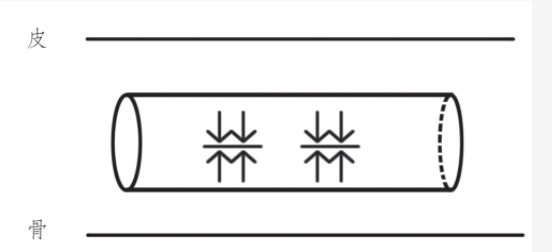
This normal string pulse pattern reflects increased tension in the vessels, obstructing the exchange of fluids.
If the image is insufficient to fully describe the specific form of the normal string pulse, what should the sensation be like?
The normal string pulse should have the following characteristics: when the hand presses on the pulse skin, the pulse shape appears straight and long like a string; when the finger presses into the pulse vessel, there is no slippery feeling, no weakness, no feeling of getting weaker with pressure, and no sensation of Qi pushing against the fingertip. Instead, there is a feeling of fullness in the vessel, but it is not as tight and lacking elasticity as a solid pulse. The specific feeling is like the pulse is filled with water. Describing it in words may still be difficult to grasp. We can imagine that a typical pulse is like an empty tube, while the normal string pulse is like a tube filled with water, which has a certain pressure, as shown in the diagram (64). This may be easier to understand.
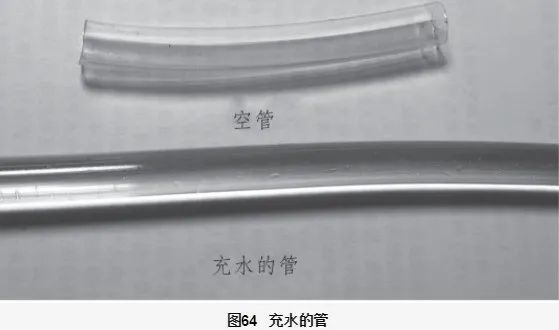
In the case of a normal string pulse, patients often experience chest tightness, cough, and asthma related to water retention in the lung system;
when the left cun shows a normal string pulse, patients often experience palpitations and heart discomfort related to water retention in the heart system;
when both cun pulses show a normal string pulse, patients often experience shortness of breath, upward Qi counterflow, cough, a sensation of foreign body in the throat, and difficulty swallowing related to water retention in the upper jiao. The treatment for upper jiao water retention is based on Ling Gui Zhu Gan Decoction. This decoction, although composed of gentle herbs, is a treasure for elderly health, as it can clear water retention from the upper jiao, significantly reducing the risk of heart and brain diseases.
Middle jiao water retention is often indicated by a normal string pulse in the guan position. If the normal string pulse appears in the right guan, it usually indicates symptoms such as abdominal distension, borborygmi, diarrhea, and belching related to water retention in the gastrointestinal system, treated with Shengjiang Xiexin Decoction or Shen Zha Decoction. If the normal string pulse appears in the left guan, it usually indicates symptoms such as poor appetite, bitter mouth, and distension and pain in the chest and hypochondrium, treated with Chai Hu Decoction.
Lower jiao water retention is often indicated by a normal string pulse in the chi pulse, usually accompanied by symptoms such as abnormal urination, low back pain, cold feet, cold lower back, cold buttocks, dizziness, and a feeling of heaviness in the head and lightness in the feet, treated with Wuling San, Zhenwu Decoction, or Fuzi Decoction.
Clinical practice has shown that patients with normal string pulses in two or more pulse positions often eventually show a weak pulse in the right guan after treatment, indicating that the treatment must conclude with a formula like Li Zhong Decoction, which fully demonstrates that phlegm is generated by the spleen and stomach. Humans cannot live without water, but they can also be harmed by it. The above discussion pertains to the situation where a normal string pulse appears in a single position while other positions are generally normal. Clinical applications must be analyzed based on specific circumstances.
2. Qi String Pulse
The string pulse overview mentioned that when a person is in a state of anger without expressing it, the pressure in the vessels increases, leading to obstruction in the exchange of Qi, resulting in the appearance of a string pulse. We can borrow the term from the “Shennong Bencao Jing” to refer to this state of “Qi obstruction” as “Jie Qi”, and we can call the string pulse in this state the “Qi string pulse.”
We can imagine a person in a state of rage, with blood vessels dilating and veins bulging, corresponding to an increased pressure state in the circulatory system. The Qi string pulse diagram can be represented as follows: as shown in diagram 65, we use two arrows to indicate that the pulse Qi force is at a normal level, while the three arrows in the diagram indicate that the pulse Qi is excessive, with a strong sensation when pressed, and the horizontal line on the arrows indicates that the pressure in the vessels is not smoothly released.
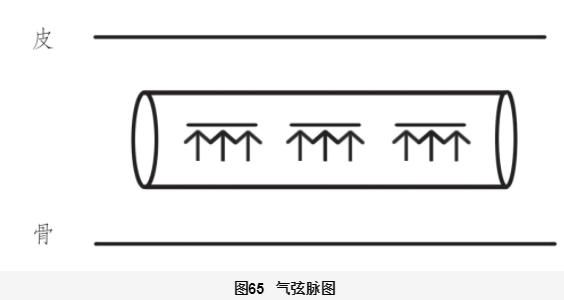
What is the sensation of the Qi string pulse like?
When we press our fingers on the pulse skin, we feel a straight and long sensation. When we press into the pulse vessel, the sensation is strong but not slippery, not normal string, and not solid. When pressing towards the center of the pulse vessel, there is a force pushing the finger away, similar to a person in anger refusing to let others approach.
The Qi string pulse represents excessive and stagnant Qi.
When the Qi string pulse appears in the floating position, we can use some aromatic Qi-regulating herbs in combination for treatment, such as Perilla leaves, Perilla stems, Tangerine leaves, Green tangerine, Aged tangerine peel, Mint, and Rose petals; when the Qi string pulse appears in the middle or deep positions, we can choose to use Si Ni San for treatment.
Clinically, the Qi string pulse is often seen in the guan position, and the guan pulse tends to be larger than in other positions.
3. Weak String Pulse
We have discussed the Qi string pulse characterized by excessive Qi in a state of anger. Correspondingly, there is a type of string pulse characterized by repressed, tense, and weak Qi, which we refer to as the weak string pulse.
We often see a type of patient who has a weak constitution, a gentle personality, and often swallows their anger, with Qi pent up in their heart. This state often leads to tension and defensiveness, which can be imagined as the circulatory system being in a state of contraction. This state reflects in the pulse manifestation as a weak string pulse.
Due to emotional “stagnation,” the microcirculation between the vessels and tissues tightens, leading to increased pressure in the vessels. We can understand that the weak string pulse, compared to the Qi string pulse, is caused by increased pressure at the input end of the vessels, while the Qi string pulse is caused by increased pressure at the output end of the vessels. We represent the weak string pulse in diagram 66, with downward arrows and horizontal lines indicating that the vessels are under input pressure.
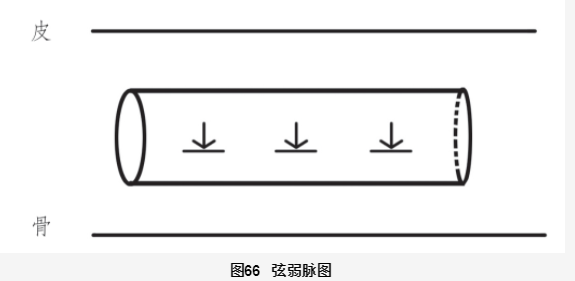
What is the sensation of the weak string pulse like?
This pulse manifestation is relatively simple: it is a string pulse with weak Qi. When the finger touches the pulse, it feels string-like, and when pressing into the pulse, the sensation of Qi is weak, without the strong sensation of the Qi string pulse. When the pulse is dominated by the weak string pulse, I usually prescribe Xiaoyao San.
4. Strong String Pulse
This pulse has a string shape and strong Qi. Compared to the Qi string pulse, the strong string pulse has even stronger Qi. Unlike the Qi string pulse, which requires pressing to the middle of the pulse to feel the pressure, this pulse is strong at floating, middle, and deep levels, indicating a liver heat syndrome in the context of organ differentiation, representing an exacerbation of Qi stagnation leading to heat.
The strong string pulse is illustrated in diagram 67.

We will use a case to illustrate the clinical application of this pulse manifestation.
Patient: Male, 32 years old. Presenting with “sudden pain and foreign body sensation in the right eye.”
On examination, a block-like hemorrhage is visible on the inner conjunctiva of the right eye, with symptoms of bitter mouth, irritability, and yellow urine. Both guan pulses are string-like and large, with strong pressure, while other pulse positions are fine, with the left cun pulse being fine and not smooth, indicating the presence of liver fire. The strong liver fire follows the meridian and naturally spills out from the weak points of the liver and gallbladder meridians, leading to conjunctival hemorrhage. The conjunctiva, being a weak blood vessel, is the first to be affected, sacrificing itself to protect other areas. Conjunctival hemorrhage is certainly better than intracranial hemorrhage. The prescription is based on Long Dan Cao Decoction, addressing the significant contradiction of excessive wood and fire. Other adjustments are minor and not critical.
The prescription is as follows: He Shou Wu 20g, Bai Zhi 12g, Ma Huang 3g, Sang Ye 10g, Da Huang 10g, Yi Mu Cao 20g, Long Dan Cao 3g, Shan Zhi Zi 10g, Che Qian Zi 15g, Mu Tong 10g, Huang Qin 10g, Gui Zhi 3g, Dang Gui 10g, Sheng Di Huang 15g, Ze Xie 15g, Sheng Gan Cao 10g, Chai Hu 15g.
3 doses.
After 2 days, follow-up via phone, with improvement in all symptoms and absorption of the hemorrhage.
5. String Pulse with Excessive Tension
The string pulse with excessive tension is a very special pulse manifestation in clinical practice. What is this pulse manifestation like?
As shown in diagram 68, this pulse is characterized by increasing strength as it becomes more floating; when lightly pressed against the pulse skin, it feels strong, but as the finger continues to press down, the strong sensation gradually weakens, becoming weaker until it feels weak and powerless at the bottom. This pulse manifestation is what we commonly refer to as the string pulse with excessive tension. This pulse involves a comparison of floating and sinking, making it difficult to explain using the vessel model.

What does this pulse manifestation reflect in terms of pathology?
This pulse is usually large, “a large pulse indicates exhaustion”, reflecting the aspect of deficiency and insufficiency; the floating pulse is strong, while the sinking pulse is weak, reflecting the aspect of internal deficiency and Yang Qi floating; the floating string pulse indicates stagnation.
From the perspective of organ differentiation, this pulse indicates “excessive liver wood dispersion.” The underlying reason is that the internal fluids are insufficient, leading to inadequate nourishment of the blood, causing dryness in the liver wood. Once the liver wood becomes dry, it will lose its ability to disperse. Due to deficiency heat, excessive Qi dispersion occurs, while dryness leads to insufficient relaxation, resulting in this special string pulse with excessive tension.
From the perspective of the six meridians, this pulse is indicative of a deficiency syndrome with concurrent Shaoyang and Yangming disease, characterized by deficiency and heat. Patients often experience irritability due to dryness, dry mouth, dry eyes, yellow urine, irritability, poor sleep, dry mucous membranes, dry skin, and red lower lips; on the other hand, they may also experience fear of wind and cold, with cold hands and feet. A weak constitution is prone to recurrent phlegm retention; Qi stagnation can lead to recurrent symptoms of Si Ni San; blood deficiency and heat can easily lead to blood stasis.
These characteristics lead to a tendency for the disease to recur, making treatment quite challenging.
The treatment for this condition, in addition to selecting prescriptions based on specific symptoms and signs, is crucially focused on replenishing the internal fluids. As long as the internal fluids are replenished, deficiency heat can be quelled, liver Qi can be relaxed, and symptoms can be alleviated. The most commonly used formulas for replenishing internal fluids are Shen Qi Wan, Liang Di Huang Wan, and Wuzi Yanzong Wan.
In clinical practice, some patients with volatile emotions have shown significant improvement in symptoms and even their temperament after using Shen Qi Wan combined with Wuzi Yanzong Wan.
We will use a case to illustrate the clinical application of this pulse manifestation.
Patient: Female, 60 years old.
Presenting with “pulling pain along the back of the lower limbs.”
The patient experiences pulling pain from the heels to the lower back, which is more pronounced when standing and alleviated when lying down or resting, with normal sleep and bowel movements. The pulse examination shows both guan pulses are string and tense, while both chi pulses are fine, indicating insufficient fluids leading to muscle nourishment, resulting in muscle spasms and pain, specifically in the heels radiating to the lower back.
The patient has a good appetite, and her spleen and stomach digestive functions are normal.Therefore, I directly used Liang Di Huang Wan to replenish fluids and Shaoyao Gan Cao Decoction to soothe liver Qi. According to the “Huangdi Neijing”: “When the liver desires to disperse… eat pungent to supplement it, eat sour to drain it.” Thus, the sour and bitter nature of Shaoyao can drain excessive liver wood Qi, while Gan Cao can alleviate its urgency, and Suan Zao Ren can nourish the liver, combined with Jin Ling Zi San to clear liver heat.
The specific prescription is as follows: Goji Berries 20g, Chuan Niu Xi 15g, Sheng Di Huang 30g, Huai Shan Yao 30g, Shan Zhu Yu 24g, Mu Dan Pi 10g, Ze Xie 10g, Fu Ling 20g, Bai Shao 24g, Zhi Gan Cao 10g, Suan Zao Ren 12g, Rou Cong Rong 8g, Chuan Lian Zi 8g, Xuan Hu Suo 8g.
Two doses.
During the second diagnosis, the patient reported that the heel pain had basically resolved, with only slight pain remaining after walking. Upon re-examination, the pulse showed a reduction in the string tension in the right guan pulse, while the left guan pulse appeared slightly weaker.
The weakness in the right guan pulse reflects the patient’s underlying spleen deficiency. Following the principle in “Jin Gui Yao Lue”: “When seeing liver disease, know that it transmits to the spleen, and one must first strengthen the spleen,” I added Li Zhong Decoction to the original formula to replenish the earth Qi, allowing the nourishing Qi to naturally arise, reducing liver Qi, and removing Jin Ling Zi San, as its cold draining nature is not suitable for spleen and kidney deficiency.
6. Slippery String Pulse
The slippery string pulse is often seen in phlegm Qi stagnation.
We will use a case to illustrate this pulse manifestation.
A woman in her 50s presents with numbness and discomfort below the knees. Upon pulse examination, both hands show a rough and obstructed pulse, with a pale and slightly dark tongue. This indicates Qi and blood deficiency, along with Qi stagnation and blood stasis. The treatment involves using Zhang Xichun’s effective Ling Huo Luo Dan combined with Huang Qi Gui Zhi Wu Wu Decoction and Si Ni San.
The prescription is as follows: Dan Shen 15g, Dang Gui 12g, Ru Xiang 5g, Huang Qi 20g, Gui Zhi 12g, Bai Shao 12g, Da Zao 10g, Sheng Jiang 10g, Chuan Niu Xi 15g, Ji Xue Teng 15g, Xi Xin 2g, Fo Shou 10g, Chai Hu 12g, Zhi Ke 12g, Xiang Fu 10g, Dai Dai Hua 10g, Xiang Yuan 10g, Mei Yao 10g, Mo Yao 5g, Di Long 10g.
5 doses.
During the second diagnosis, the patient reported that after taking 2 doses, the numbness in her feet had resolved, but she experienced pain in her left knee. When asked when the pain started, she mentioned it had been ongoing for a long time, but she had not paid attention to it until the numbness became severe. Now she hopes to treat the knee pain as well. Upon re-examination, the pulse showed changes compared to before. The left hand pulse remains fine, indicating blood deficiency, while the right guan pulse appears string and slippery.
This slippery string pulse indicates that the pulse feels string-like when pressed, but when pressing into the pulse vessel, the Qi feels smooth and flowing like beads.
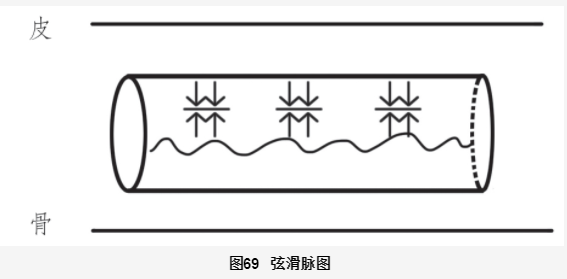
The left hand pulse is fine, indicating blood deficiency, while the knee is the residence of the tendons. Blood deficiency leads to a lack of nourishment. The right guan pulse being string and slippery indicates phlegm stagnation, obstructing Qi flow, leading to knee pain. The treatment involves using Si Wu Decoction combined with Huang Qi Gui Zhi Wu Wu Decoction to nourish blood and unblock the meridians, along with Fu Ling Decoction to eliminate phlegm and turbidity from the middle burner. The specific prescription is as follows:
Dan Shen 15g, Dang Gui 15g, Huang Qi 20g, Gui Zhi 10g, Bai Shao 20g, Da Zao 10g, Sheng Jiang 10g, Ji Xue Teng 15g, Dang Shen 15g, Bai Zhu 15g, Fu Ling 15g, Zhi Shi 12g, Xing Ren 15g, Ban Xia 10g, Zhi Gan Cao 6g, Sheng Di Huang 20g, Mu Guo 15g, Chuan Xiong 12g.
5 doses.
After 4 days of follow-up, the patient reported that the knee pain had resolved. This case indicates that the presence of a slippery string pulse is a manifestation of phlegm stagnation obstructing Qi flow.
Why use Fu Ling Decoction for the right guan pulse with a slippery string pulse instead of Er Chen Decoction? If it were purely a slippery pulse, Er Chen Decoction would certainly be appropriate. However, if it is a slippery string pulse, the presence of the string pulse indicates that there are components of Qi stagnation and fluid retention, so Fu Ling Decoction, which contains Fu Ling and Bai Zhu, targets this water retention, while Zhi Shi in Fu Ling Decoction can address the Qi stagnation, making it more suitable than Er Chen Decoction.
7. String Pulse with Excessive Tension and Slippery
This pulse manifestation corresponds to a syndrome of liver wind combined with phlegm, which is also commonly seen in clinical practice. Let’s illustrate this with a case.
A 60-year-old female patient presents with dizziness for 2 weeks, with symptoms triggered by turning over in bed, standing up, or lying down, accompanied by a sensation of spinning, excessive sweating, no palpitations, no dry mouth, no headache, no fear of wind or cold, no irritability, and severe insomnia. Her appetite is normal, and her bowel and urination are regular. Pulse examination shows an overall string pulse with excessive tension and slipperiness, with a white, thick tongue coating.
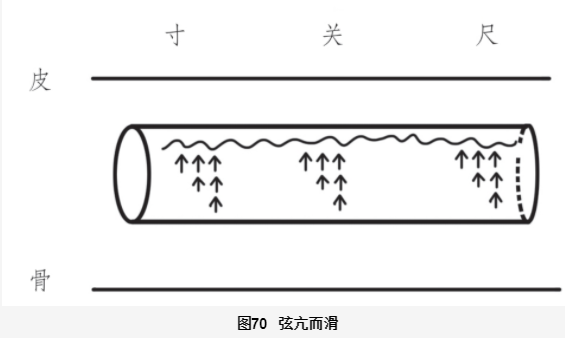

This pulse has a string-like sensation, with a slippery and strong feeling at the surface, while the deeper pulse becomes weaker, indicating that the strong and slippery Qi at the surface is related to the weakening of the pulse at deeper levels. This indicates that the excessive Qi and phlegm are both due to internal deficiency. Based on the pulse analysis, the prescription is as follows: Sheng Ban Xia 20g, Bai Zhu 45g, Tian Ma 15g, Chen Pi 15g, Ze Xie 60g, Mu Li 30g, E Jiao 10g, Fu Ling 60g, Sheng Jiang 20g, Qian Shi 30g, Shen Fu 15g, Bai Shao 25g.
3 doses.
The prescription uses Ban Xia Bai Zhu Tian Ma Decoction to eliminate the floating wind phlegm, while Zhang Xichun’s phlegm treatment addresses the internal deficiency phlegm syndrome, and Zhen Wu Decoction addresses the water syndrome caused by internal deficiency, with E Jiao quickly replenishing the internal fluids. Many times, E Jiao is also an excellent remedy for phlegm.
After taking the medicine, the patient was able to sleep, and the dizziness during turning over in bed was alleviated, with only slight dizziness occurring when looking down or raising her head.
8. Tight String Pulse
Tightness indicates cold, while string indicates phlegm. Therefore, this tight string pulse is a typical pulse manifestation of cold combined with phlegm, which we will discuss based on the pulse of Xiao Qing Long Decoction.
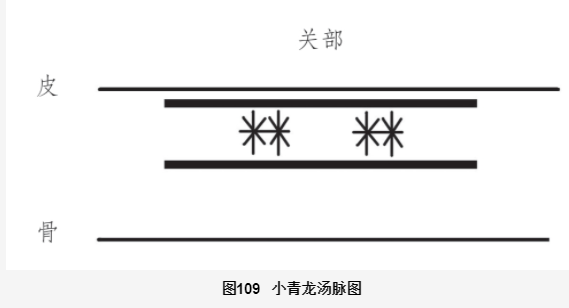

In “Shang Han Lun”: “If the exterior of a cold injury does not resolve, and there is water Qi in the heart, leading to dry vomiting, fever, cough, thirst, diarrhea, abdominal fullness, or difficulty urinating, Xiao Qing Long Decoction is indicated.”
Xiao Qing Long Decoction is used for external wind-cold with internal phlegm retention. Clinically, this decoction is often used for cough and asthma. The characteristics of this cough are white, foamy phlegm, worsening after exposure to rain or swimming, and the most characteristic pulse manifestation.
In clinical practice, whenever this pulse is observed, using this formula will yield good results. We will illustrate the characteristics of this pulse with a case.
Patient: 8 years old, presenting with recurrent cough, having undergone multiple treatments with no improvement. Previous doctors prescribed cough suppressants with no effect after two adjustments.
Currently, the patient has a cough, with a white, thick tongue coating, and both guan pulses are floating, string, and tight.
This is a typical pulse for Xiao Qing Long Decoction. Due to the thick white tongue coating, I added some digestive herbs to the prescription, which is as follows:
Bai Shao 15g, Gan Jiang 8g, Wu Wei Zi 6g, Ma Huang 6g, Zhi Gan Cao 6g, Xi Xin 3g, Ban Xia 10g, Gui Zhi 10g, Shi Gao 15g, Shen Qu 10g, Mai Ya 10g, Shan Zha 10g, Ji Shi Teng 20g, Chen Pi 6g, Cang Zhu 10g.
3 doses.
After just one dose, the mother reported that the cough had significantly reduced and was nearly cured.
In clinical practice, whenever both hands show a floating, string, and tight pulse, regardless of whether it is a cough or other symptoms, I use Xiao Qing Long Decoction with adjustments. Of course, if the pulse is not accurately identified as floating, string, and tight, the effect of Xiao Qing Long Decoction will not be good.
I once treated a stubborn cough patient whose pulse was double floating, string, and tight, but the pulse Qi was weak. I used Xiao Qing Long Decoction with Ren Shen and a large dose of Huang Qi for effect; I also treated a cough patient whose pulse was double floating, string, and tight, but the right cun pulse was floating, tight, and sinking, using Xiao Qing Long Decoction with Ma Xing Shi Gan Decoction for effect; I treated a patient with abdominal distension and pain who had sought treatment for many years with no effect, whose double hands showed a floating, string, and long pulse, using Xiao Jian Zhong Decoction with increased doses of Gui Zhi and Bai Shao, with repeated adjustments, ultimately nourishing kidney essence and curing the condition; I treated a chronic rhinitis patient whose double guan and chi pulses were floating, string, and tight, while the double cun pulses were weak, using Xiao Qing Long Decoction with Bu Zhong Yi Qi Decoction to achieve good results.
This article is excerpted from “Illustrated Pulse Diagnosis,” copyright belongs to the relevant rights holders. Sharing this article is for the purpose of dissemination and learning exchange. If there are any improper uses, please feel free to contact us for deletion.

